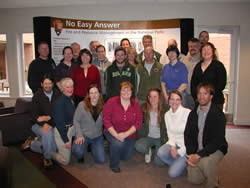
National Fire Plan Success Story
Information, Please
NPS Northeast Region, Virginia Department of Forestry, Virginia
National Fire Plan - Firefighting
2008

Participants and some of the cadre from Introduction to Incident Information in Charlottesville, Virginia. Photo by Fred X. Turck.
Firefighting attracts attention. Information officers serve the concerned and the curious, so firefighters can focus on the fire. In March 2008, a group of federal and state employees successfully completed the National Wildfire Coordinating Group (NWCG) course, Introduction to Incident Information (S-203) in Charlottesville, Virginia. The National Park Service Northeast Region and the Virginia Department of Forestry sponsored the training.
Course participants came with an excellent mix of skills and left with even more. Fire, public affairs and public contact were represented by the students from the Virginia Department of Forestry (VDOF), the U.S. Forest Service (USFS), the Pennsylvania Bureau of Forestry, the New Jersey Forest Fire Service and the National Park Service (NPS). The VDOF, USFS, and NPS provided instructors and role players. Everyone learned in formal sessions and discussions over dinner.
The course included a media panel. Students and cadre heard directly from representatives of the Associated Press, Charlottesville Radio Group, The Washington Post, WHSV-TV, and WVIR-TV. The reporters and editor spoke openly, even passionately, about the needs and advantages of their organizations in the 21st century. Information officers must be able to work in the 19th century world of taking notes by hand and in modern era of the internet and satellite communications.
Another highlight for the participants and instructors was the live-action scenario. For about three hours, students became information officers while other agency employees played the roles of reporters, neighbors, stressed bureaucrats, and an assortment of characters drawn from real fires. Students had the opportunity to practice the knowledge and skills they had enhanced during the course. Feelings ran the gamut of frustration, satisfaction, uncertainty, and joy. When it was over, they had an even better idea of what it takes to serve the people, who are, think, or feel a fire affects them.
Contact: Barbara J. Stewart, Fire Communication and Education Specialist, NPS; phone: (434) 220-9065.